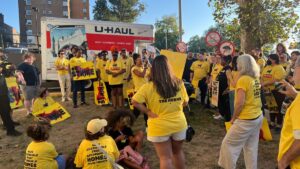8:11
News Story
New Kansas City housing subsidies set by ZIP code could avoid segregating renters
For generations, federal housing subsidies have provided a lifeline to families struggling to afford rent.
But the maximum amount families got for rent stayed the same regardless of which neighborhood best suited their needs — effectively segregating them into low-income areas.
Come this fall, the rent cap for a standard apartment will vary from one Kansas City ZIP code to the next.
Experts see the new program — Small Area Fair Market Rents, or SAFMR — as a game changer giving families access to neighborhoods they have been essentially shut out of. That could mean putting families closer to fresh produce and better schools and moving them out of high-crime areas.
But by raising the subsidies in some neighborhoods, the program will eat through federal dollars more quickly and make those Section 8 rent vouchers available to fewer families.
“This means that you’re not artificially stuck with a voucher that has a cap on its ability to pay,” said Brian Handshy, regional spokesperson for the U.S. Department of Housing and Urban Development. “Raising the (fair market value) is not going to solve everything completely. But it certainly empowers the tenant to have more ability to push back on (money) constraints.”
Regional housing authorities across the metro have until the end of this year to roll out their ZIP code-based subsidies.
Why will Kansas City section 8 use SAFMR?
HUD will publish the subsidies for 2025 on Oct.1. Small area fair market rents will only affect new voucher users. Current leases will be upheld unless a landlord requests a rent increase.
Local housing agencies currently pay up to $1,098 for a one-bedroom and $1,258 for a two-bedroom.
That’s based on the federal government’s calculation of fair market rents set by the average rent of standard quality units — or nonluxury apartments that are more than two years old offering basic amenities.
Housing authorities will then make sure that the rent charged for an individual unit is reasonably priced in comparison to other units in the area. The tenant will pay about 30% of their income for rent and the housing authority pays the rest.
“Under the fair market rents, you have that lower benchmark that housing authorities set their payment with,” Handshy said. “That’s been a problem in these last few years with rising rental costs.”
Last year, Kansas City was chosen as one of 41 additional metro areas to participate in SAFMRs, because at least 20% of its standard rentals are in ZIP codes with fair market rents significantly higher than the citywide average.
“If we found that there’s only one or two ZIP codes where that was a challenge, then there’s really no reason to force that housing authority in that ZIP code to go to small area,” Handshy said. “But that’s not what we’re seeing for Kansas City.”
Edwin Lowndes is the executive director for the Housing Authority of Kansas City, which serves Kansas City proper, Raytown, Grandview and Gladstone. He said most of the region’s high-income neighborhoods are in the suburbs, where low-income residents often can’t afford to stay. Based on 2024 calculations from HUD, SAFMR would significantly increase voucher payouts in those areas.
In southern Johnson County, where the median household income is $109,363, the housing authority would pay up to $1,650 for a one-bedroom apartment and $1,890 for a two-bedroom.
This would place voucher holders within the range to afford a standard apartment in the area, where the average rent for a one-bedroom apartment is $1,219 and the average rent for a two-bedroom is $1,521, according to Apartments.com. Luxury apartments, however, can go for rents twice as high.
Voucher holders could also move to downtown neighborhoods like Quality Hill and the Garment District, where a voucher for one bedroom would pay up to $1,500. A two-bedroom would max out at $1,720.
In areas where the rent average is lower than the region’s, the voucher amount will decrease. That would apply in the area stretching east of The Paseo extending to Eastwood Park, where the median household income is $28,493. In that area, rent subsidies would decrease to $970 for a one-bedroom and $1,110 for a two-bedroom apartment. About 12% of current voucher holders live in that area currently, Lowndes said.
What impact could SAFMR have on the market?
Income segregation traps poor residents in neighborhoods with fewer opportunities and resources.
Low-income housing often exists in food deserts or neighborhoods that have limited access to nutritious food. A 2021 study by the Journal of the Academy of Nutrition and Dietetics found that families facing housing instability are 40% more likely to face food insecurity.
Without access to healthy meals, low-income residents are at a higher risk for diet-related health conditions, such as obesity, diabetes and cardiovascular disease.
Schools in high-poverty neighborhoods have fewer instructors, less access to high-level coursework and lower levels of state and local funding. The Kansas City Public Schools system has a long history of segregation and inefficiency.
And without other vital resources — such as health care and job opportunities — low-income neighborhoods are more likely to be affected by crime than high-income neighborhoods.
Kansas City’s shift to SAFMR reflects a national trend in housing policy. HUD required 24 other metro areas to make the switch in 2018. The Housing Authority of Cook County, Illinois, was an early adopter in 2012. Voucher payments in Cook County were too low to allow poorer families to move into its more prosperous northern suburbs.
Switching to SAFMR allowed voucher payments to better reflect market rents in high-rent areas. Landlords then became more receptive to the program. And the number of units in high-income areas available to voucher holders rose by 14% in 5 years.
New payment standards for the housing voucher program could bring similar changes for the 17,586 people on Kansas City’s voucher wait list, Lowndes said.
Does SAFMR have any unintended consequences?
Candace Ladd, outreach coordinator for the Heartland Center for Jobs and Freedom, is optimistic about the new payment standard. Her organization provides free legal aid to renters and she believes SAFMR, combined with legislation preventing landlords from discriminating against voucher holders, will let tenants explore previously out-of-reach neighborhoods.
But she worries the smaller subsidies for apartments in poorer neighborhoods could cut off access to some housing. Voucher holders already struggle to find something they can afford even outside of high-income neighborhoods due to rising rents.
In Cook County, while the number of affordable apartments in high-income areas increased by 14% under SAFMR, the number of affordable units in low-income areas decreased by 14% in five years.
“If a tenant’s not able to find a home within a certain period of time, they actually lose that voucher and have to start all over,” she said. “So If a tenant isn’t able to rent in a certain area of town any longer because that voucher is too low, they’ll miss out on the voucher entirely.”
But Lowndes said that having more housing options should speed up the process for tenants.
“They can go to wherever they want … and there should be a higher probability that the rents will be approved,” he said.
Instead, Lowndes said HUD should watch out for the negative impact higher rent subsidies will have on the amount of vouchers the housing authority can give. HAKC gets $60 million a year to pay landlords, he said. They will not be getting any additional funding in 2025.
“There are conflicting aspects. We want families to move to high-opportunity neighborhoods but that means they cost more,” Lowndes said. “Higher rents mean more funds are paid out on behalf of the tenants, which means we can serve fewer people.”
This article first appeared on The Beacon and is republished here under a Creative Commons license.![]()
Our stories may be republished online or in print under Creative Commons license CC BY-NC-ND 4.0. We ask that you edit only for style or to shorten, provide proper attribution and link to our website. AP and Getty images may not be republished. Please see our republishing guidelines for use of any other photos and graphics.





